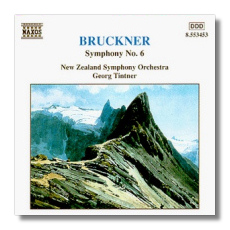
The Internet's Premier Classical Music Source
Related Links
- Bruckner Reviews
- Latest Reviews
- More Reviews
-
By Composer
-
Collections
DVD & Blu-ray
Books
Concert Reviews
Articles/Interviews
Software
Audio
Search Amazon
Recommended Links
Site News
 CD Review
CD Review


Saarbrucken Radio Symphony Orchestra/Stanlislaw Skrowaczewski
Arte Nova 54456
Bruckner's 6th Symphony is my favorite Bruckner Symphony. It was first performed complete in Stuttgart under Karl Pohlig in 1901. Pohlig was replaced by Leopold Stokowski at the Philadelphia Orchestra in 1912. These locutions have nothing logically connecting them. They are proof of my theory that sentences can be grammatically correct and that 'meaning' is sometimes established tangentially.
These discs arrived about the same time and it made me realize the impact that Klaus Heymann has had on recorded classical music since the advent of the CD. Naxos has been a class act from the outset, presenting excellent recordings inexpensively, and with excellent orchestras otherwise never heard of. The Arte Nova disc is a relatively new line, distributed by RCA. I have seen the discs priced as low as $3.99 at Borders. Yes, I said BORDERS! They probably give them away at larger chains. Anyway, the success of Naxos has obviously prompted the other "major" labels to compete in this price range. You can bet that RCA's budget entry, to mention but one such example, is a response to the success of Klaus Heymann.
So, what, you ask, prithee about the review of these discs?? Good question. Well, let me begin by telling you that whenever I listen to the 'main theme' of the first movement, which opens and closes it, for some reason I envision Laurence of Arabia riding his camel across an Arabian desert. I don't explain them, I just report them. I love it. The insert notes in the discs above range from puzzling in the Arte Nova to 'must read' in the Naxos. The Arte Nova disc's, written by Doris Lipka, indicate that the 6th is marked, "Pastorale" on the score. Odd, I haven't come across that bit of information before.
Many of you will recall Maestro Skrowaczewski from recordings he made with the Minneapolis Symphony. Those recordings were not as widely appreciated as some from more 'major' orchestras. I recall, however, some fine Ravel LPs my father had in his collection. So, I looked forward to hearing what he was doing now. As I listened to the disc (and it arrived before the Naxos) I felt that it was a good recording and interpretation. Compared with the classic Klemperer, however, it lacked the last ounce of spirituality and bite that the music should have. So, I wrote that it was 'good for the price' in my initial notes.
Then the Naxos disc arrived and changed all that. I had heard the Bruckner 5th by Tintner and was less enthusiastic than other writers. The sound seemed congested and I felt there were details hinted at that were obscured by the recording. I listened to my recording of the piece by Furtwängler and preferred it, even though it was in monaural sound. I also realized while listening to the Furtwängler that I didn't care for the 5th as much as other Bruckner works. This recording of the 6th however, transcends all others I have heard. It is not only 'good for the price' it is the finest I have heard at any price. Given that it is but a few dollars more, depending upon where you shop, than the Arte Nova I would certainly recommend Tintner over the other 'budget' recording.
Details? Well, they are many. The phrase that kept appearing in my notes is "there is majesty here." The sound is wonderful. The sound stage is realistic, there is air around the music, an inner depth. The relief (as Stokowski put it) or orchestral balance is perfect!!! The horns have a burnished glow to them that melts my heart. The strings are rich and the bass line full and firm. It sounds like I would imagine Stokowski having done with the piece. A great performance of any symphony must have an ebb and flow like that of the pulse of Life. You can feel this in the recordings by Walter, Furtwängler and Klemperer, to mention but a few of the master Brucknarians. Tintner's Bruckner 6th has this pulse. You can 'feel' the music as you listen to it.
Then, too, this whole review has been a chance to revisit Bruckner. I re-read Steinberg's commentary about the symphony, and read the insert notes of these discs and Klemperer's. I'd forgotten Bruckner was an organist, which certainly explains the sonorities he strives for in his symphonies. It also explains why I prefer Tintner to Skrowaczewski, Tintner's recording casts a glow to the piece not unlike an organ sonority. I can hear the voice of God in the music. This is a God, however, of the mountains. In fact, the reproduced picture on the cover is apt, Tirolean Mountain Landscape by Thomas Ender. I found myself gazing at the art work as I listened. The Naxos notes were written by Maestro Tintner and are interesting as well as insightful. While I beg to differ with the Maestro's opinion of the final movement, his comment "Bruckner's music touches the innermost recesses of the human soul." is certainly borne out by this recording.
I could go on and on, but you have by now figured out that this is another Naxos masterpiece. Once more we are indebted to Klaus Heymann for providing us with a masterly recording. At the price, it would be sin to not buy to this disc.
Copyright © 1998, Robert Stumpf II



















